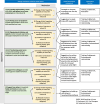Are we working (too) comfortably?: the systematic development of an intervention to support workers to move more while working at home
- PMID: 40551143
- PMCID: PMC12183816
- DOI: 10.1186/s12966-025-01762-3
Are we working (too) comfortably?: the systematic development of an intervention to support workers to move more while working at home
Abstract
Background: Covid-19 accelerated a transformational change in working practices, with a considerable proportion of desk-based workers now engaged in home or hybrid working. Working at home appears to exacerbate the already elevated levels of unhealthy occupational sedentary behaviour, and there is a need to support employees to reduce sedentary behaviour while working at home. The aim of this study was to develop an intervention to support employees to reduce sedentary behaviour when working at home utilising the novel integration of the Six Steps in Quality Intervention Development (6SQuID) and Behaviour Change Wheel (BCW) intervention development frameworks.
Methods: We report on 6SQuID steps 1-5, with the Capability, Opportunity and Motivation influence on Behaviour (COM-B) model integrated into steps 1-4, providing a theoretical organising framework. In step 4, the intervention functions and behaviour change technique elements of the BCW were used to accurately and consistently specify the active ingredients of the intervention. The test and refine phase of 6SQuID (step 5) evaluated the acceptability of elements of the intervention with a sample of Scottish Government employees.
Results: The causal factors for employee sedentary behaviour while working at home were delineated, and theory of change/action models were constructed. Intervention components were developed to address causal factors and presented as a toolkit on an online platform. These comprised: 1) education on sedentary behaviour, 2) resources to aid intention formation and action planning, 3) strategies to increase movement, and 4) suggestions for support from colleagues/friends/family. Strategies aimed at line managers and organisations to support employees and create an organisational culture that enables employees to move more were also developed. The acceptability testing demonstrated the value of the toolkit format incorporating a suite of strategies, and feedback informed refinement of the toolkit.
Conclusions: This study addresses the urgent need to support employees to reduce sedentary behaviour while working at home. Using the novel application of integrated intervention development frameworks, a comprehensive intervention toolkit has been formulated and preliminarily tested. The toolkit comprises strategies and resources for employees, line managers and organisations. Further feasibility and effectiveness testing with a larger sample is recommended prior to large-scale implementation.
Keywords: Desk-based employees; Intervention development; Occupational health; Sedentary behaviour; Work from home.
© 2025. The Author(s).
Conflict of interest statement
Declarations. Ethics approval and consent to participate: For data reported in Step 5, ethics approval was procured from Moray House School of Education and Sport Research Ethics Committee, University of Edinburgh (Ref: SMOR03102022). Consent for publication: Not applicable. Competing interests: The authors declare no competing interests.
Figures





Similar articles
-
Workplace interventions to reduce the risk of SARS-CoV-2 infection outside of healthcare settings.Cochrane Database Syst Rev. 2022 May 6;5(5):CD015112. doi: 10.1002/14651858.CD015112.pub2. Cochrane Database Syst Rev. 2022. Update in: Cochrane Database Syst Rev. 2024 Apr 10;4:CD015112. doi: 10.1002/14651858.CD015112.pub3. PMID: 35514111 Free PMC article. Updated.
-
Interventions for promoting habitual exercise in people living with and beyond cancer.Cochrane Database Syst Rev. 2018 Sep 19;9(9):CD010192. doi: 10.1002/14651858.CD010192.pub3. Cochrane Database Syst Rev. 2018. PMID: 30229557 Free PMC article.
-
Effectiveness of workplace interventions with digital elements to reduce sedentary behaviours in office employees: a systematic review and meta-analysis.Int J Behav Nutr Phys Act. 2024 Apr 19;21(1):41. doi: 10.1186/s12966-024-01595-6. Int J Behav Nutr Phys Act. 2024. PMID: 38641816 Free PMC article.
-
Home treatment for mental health problems: a systematic review.Health Technol Assess. 2001;5(15):1-139. doi: 10.3310/hta5150. Health Technol Assess. 2001. PMID: 11532236
-
A digital intervention to reduce home-office workers' sedentary behaviour: protocol for the evaluation of the Click2Move programme, a cluster randomised controlled trial.BMC Public Health. 2025 Jan 30;25(1):387. doi: 10.1186/s12889-025-21598-7. BMC Public Health. 2025. PMID: 39885479 Free PMC article.
References
MeSH terms
Grants and funding
LinkOut - more resources
Full Text Sources
Medical

